1. The aim of sorting: introduction
The aim of sorting is assigning objects, persons, cars, suppliers, ... actions to predefined groups or categories. The groups are said to be predefined because we know at forehand the meaning of each group. Hotels are assigned to different categories (two star, three star, etc.), cyclons are assigned to different categories on a specific scale (very dangerous, dangerous, etc.) Let us consider another task of assigning projects to the group rejected or accepted. In other words, the decision maker has several projects and wants to differentiate them. He willl assign them to one of the predefined groups: he therefore needs to define what is an accepted project and a rejected project. An other example is the evaluation of suppliers of a company. It might be worth to strengthen some relationships with strategic partners whereas stop collaboration with other suppliers. Therefore, we usually define 4 different type of supplier: suppliers for strategic partnerships, promising suppliers that must be supported via supplier development programs, suppliers for competitive partnerships: they have to be considered for competitive partnerships and suppliers to be pruned: they should no longer be considered for the partnership in any levelsuppliers to be pruned.So, the aim of sorting is thus to regroup similar actions into groups which are completely ordered: i.e. there is a preference order on the groups: the decision maker preferes the accepted projects ; the supplier for strategic partnerships, the less dangerous cyclons, etc. There is a preference relation between the groups.
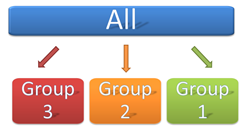
2. Definition of the categories
As metionned in the introduction, the decision maker needs to define the meaning of a group: what is a four star hotel, what is a rejected project, what is a strategic partner, etc. The user will have to define his categories by means of a profiile. A profile is an action, project, hotel, which represents either a boundary between two groups or a group in itself. Therefore, we speak either about limiting profiles or about central profiles.
1. Limiting profiles
When we speak about limiting profiles, we speak about what defines the boundary between two groups. In the picture here belows, at the left figure, we have three categories defined by two boundaries: a boundary between group 1 and group 2 ; a boundary between group 2 and group 3. We define the first boundarty by thinking of its evaluation on the criteria which are important for the definition of the categories. In our example below, we only used three criteria (price, power and age) and give respectively the following performances to the first boundary: 50,150,2 ; to the second boundary: 100,70 and 4.In the left case we speak about open-categories because the best and the worst categories are not completely defined: the best category is open on the right and the worst category non the left.
On the right case we spaek about closed categories because we need two more limits or frontiers to complete defined the categories (two blue frontiers) ; this permits to exclude some actions from those categoiries.
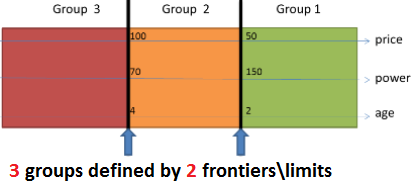 |
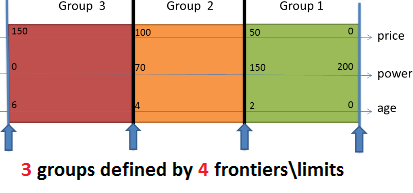 |
Let us remark that the profiles dominate each other: a frontier of group 1 and 2 is always better on all the criteria then a frontier of group 2 and group 3. Being better means thats since the price have to be minimized, the profiles of better categories are cheaper than the profiles of worse categories (0 < 50 < 100 < 150)). On the other hand, if the criterion has to be maximized, the value of the better profiles are higher than the worse profiles (e.g. 200 > 150 > 70 > 0 for the right case).
2. Central profiles
Another way of defininf the profiles is to use a prototype or a typical representative element. In this case, each group or category will be defined by one particular action which represents well the group. For instance, group 1 is defined by an action which performances are respectively 25, 175 and 1 on the different criteria. Here again, the central profile dominate each other : 25 < 75 < 125 on the price, 1 < 3 < 5 on the age and power (which has to be maximized) 175 > 110 > 35.group defin
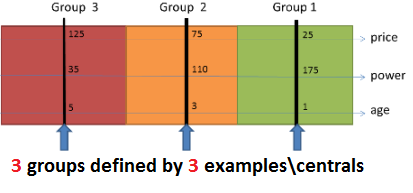
3. Conditions on the profiles
The profiles must follow the following conditions:- the profiles must be ordered from the best to the worst ; so, on the first line there need to be the best profile, then the second,m the third, etc. and on the last line, the worst.
- the profiles must dominate each other (see Condition of dominance).
If the profiles do not respect the first condition, e.g. here be below. If you want to sort the action, you will have the first warning message which proposes you to reoder automatically the profiles. If the program succeeds, it will propose you to rename the profiiles in order to respect the name of the categories.
Step 1: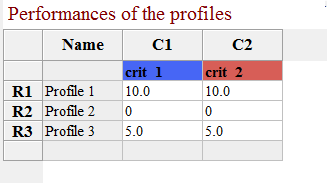 |
Step 2: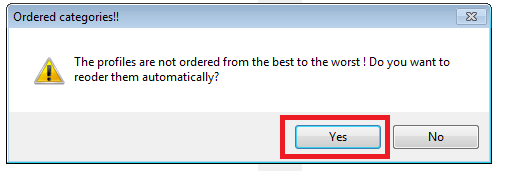 |
Step 3: |
Step 4: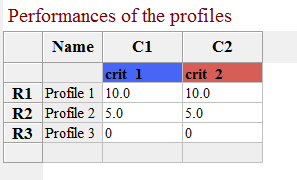 |
In the following example, it will not be possible to reoder automatically the profiles (because they do not dominate each other: 10-5 and 5-10 ). However, the program will tell where the problems are.
Step 1: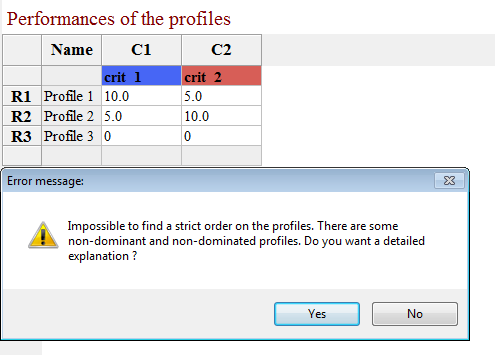 |
Step 2: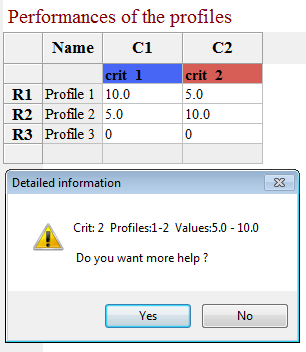 |
4. Changing the definition of the groups
You can define the way of defining the groups, either by the Sorting Menu (on the left) or by the list-boxes (limiting profiles and open classes) on the right.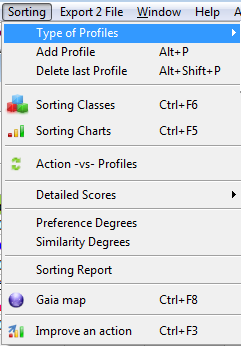 |
 |